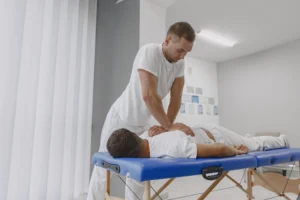
Unlocking Wellness: The Ultimate Guide to the Benefits of Massage Therapy for Mind and Body
In our fast-paced world, finding balance can often feel like an uphill battle. Enter massage therapy—a time-honored practice that goes beyond mere relaxation. This ultimate guide delves into the incredible benefits of massage therapy for both mind and body, showcasing how a simple touch can unlock a wealth of wellness. From reducing stress and anxiety to alleviating physical pain and boosting immune function, massage therapy offers a holistic approach to self-care that rejuvenates and revitalizes. Whether you’re a seasoned spa-goer or just curious about its healing properties, this guide will illuminate the transformative effects of massage, revealing techniques and benefits that can enhance your overall well-being. Get ready to explore how incorporating massage therapy into your routine can lead to a healthier, happier you!
The History and Evolution of Massage Therapy
Massage therapy is one of the oldest healing practices in human history, with its roots tracing back thousands of years.

Ancient civilizations such as the Egyptians, Chinese, and Greeks revered the power of touch for its physical and emotional healing properties. In China, records dating back to 2700 BCE describe therapeutic massage as a critical part of traditional medicine, combined with acupuncture and herbal remedies to treat a variety of ailments. Meanwhile, in Egypt, ancient hieroglyphics depict scenes of massage, indicating its importance in their daily lives and spiritual practices.
As we move to ancient Greece, the significance of massage therapy becomes even more apparent. The Greeks, particularly Hippocrates, known as the “Father of Medicine,” advocated the use of massage for its health benefits. He believed that rubbing or anointing with oils could restore the body’s natural balance and promote overall well-being. This practice was not only reserved for healing the sick but also for athletes who used massage to enhance their performance and recover from physical exertion.

The tradition continued through the Roman Empire, where physicians like Galen integrated massage into medical treatments, emphasizing its role in maintaining physical health.
Over the centuries, the practice of massage has evolved, incorporating techniques from various cultures and adapting to the needs of modern society. The 19th century saw the development of Swedish massage, pioneered by Per Henrik Ling, which laid the foundation for many contemporary massage techniques. Today, massage therapy is recognized globally as a complementary and alternative medicine, blending ancient wisdom with modern science. Its evolution reflects our growing understanding of the mind-body connection and the importance of holistic approaches to health and wellness.
How Massage Therapy Works: The Science Behind It
The effectiveness of massage therapy lies in its ability to manipulate the body’s soft tissues through techniques such as kneading, tapping, and applying pressure. This physical interaction stimulates various physiological responses that contribute to its wide range of benefits.

One primary effect of massage is the improvement of blood circulation. The pressure applied during a massage helps move blood through congested areas, enhancing oxygen and nutrient delivery to tissues and facilitating the removal of metabolic waste products. Improved circulation can lead to faster recovery from injuries, reduced muscle soreness, and overall better physical health.
Another significant aspect of massage therapy is its impact on the nervous system. The manipulation of the skin and muscles activates the parasympathetic nervous system, which is responsible for the body’s “rest and digest” functions. This activation helps lower heart rate, reduce blood pressure, and promote relaxation. Additionally, massage stimulates the release of endorphins, the body’s natural painkillers, and mood enhancers. These neurochemicals help reduce stress and anxiety, improve mood, and create a sense of well-being. The reduction of cortisol, a stress hormone, further supports these calming effects, making massage an effective tool for managing stress-related conditions.

Furthermore, massage therapy influences the lymphatic system, which plays a crucial role in immune function and detoxification. The gentle pressure and rhythmic movements of massage help stimulate lymph flow, enhancing the body’s ability to remove toxins and fight infections. This boost in lymphatic circulation can lead to improved immune response and overall health. The comprehensive impact of massage on the body’s systems underscores its potential as a multifaceted therapeutic approach, addressing both physical and mental health needs.
Physical Benefits of Massage Therapy
Massage therapy offers a plethora of physical benefits that cater to a wide range of health needs. One of the most well-known advantages is its ability to alleviate muscle tension and pain. By targeting specific muscle groups and applying appropriate pressure, massage therapists can help release knots and tightness, improving flexibility and range of motion. This is particularly beneficial for individuals suffering from conditions such as chronic back pain, sciatica, and fibromyalgia.

Regular massage sessions can significantly reduce pain levels, enhance mobility, and improve the quality of life for those dealing with persistent discomfort.
In addition to pain relief, massage therapy is highly effective in promoting faster recovery from injuries. Whether it’s a sports-related injury, a surgical procedure, or a strain from daily activities, massage can accelerate the healing process. Techniques such as deep tissue massage and myofascial release help break down scar tissue, reduce inflammation, and improve circulation to the affected area. This not only speeds up recovery but also helps prevent future injuries by keeping the muscles and connective tissues healthy and resilient.
Massage therapy also plays a vital role in enhancing athletic performance. Athletes of all levels—from weekend warriors to professional competitors—use massage to prepare their bodies for intense physical activity and to recover afterward. Pre-event massages can help warm up the muscles, increase flexibility, and reduce the risk of injury.

Post-event massages, on the other hand, aid in flushing out metabolic waste, reducing muscle soreness, and promoting relaxation. By incorporating massage into their training regimen, athletes can maintain peak performance and reduce downtime due to injuries.
Mental and Emotional Benefits of Massage Therapy
While the physical benefits of massage therapy are well-documented, its impact on mental and emotional well-being is equally profound. One of the primary psychological advantages of massage is its ability to reduce stress. In today’s fast-paced world, stress has become a ubiquitous part of life, leading to a host of health issues such as anxiety, depression, and burnout. Massage therapy provides a sanctuary of calm, where the mind can unwind and the body can release built-up tension. The soothing touch of a skilled therapist can lower cortisol levels, the hormone responsible for stress, and increase the production of serotonin and dopamine, neurotransmitters that promote feelings of happiness and relaxation.

Beyond stress relief, massage therapy is a powerful tool for managing anxiety and depression. The physical act of touch has been shown to trigger the release of oxytocin, often referred to as the “love hormone,” which fosters a sense of connection and emotional security. This can be particularly beneficial for individuals experiencing loneliness or social isolation. The nurturing environment of a massage session provides a safe space for emotional release, helping clients process feelings of sadness, grief, and worry. Regular massage therapy can lead to long-term improvements in mood and emotional resilience, making it a valuable component of a comprehensive mental health strategy.
Moreover, massage therapy enhances overall mental clarity and cognitive function. The relaxation induced by massage helps improve sleep quality, which is crucial for optimal brain function. A well-rested mind is better equipped to handle daily challenges, think creatively, and make sound decisions.

Additionally, the reduction of muscle tension and pain through massage can alleviate physical distractions, allowing the mind to focus more effectively. Whether it’s preparing for a big presentation, studying for exams, or simply navigating the complexities of daily life, the mental benefits of massage therapy can provide a significant edge.
Different Types of Massage Therapy
The world of massage therapy is rich with diverse techniques, each offering unique benefits tailored to specific needs. Swedish massage, perhaps the most popular, involves long, gliding strokes, kneading, and circular movements on the topmost layers of muscles. This technique is designed to relax the entire body, improve circulation, and relieve muscle tension. It’s an excellent choice for beginners or those seeking a gentle and soothing experience. The rhythmic flow of Swedish massage not only alleviates physical discomfort but also promotes a profound sense of relaxation and well-being.
For those dealing with chronic pain or muscle stiffness, deep tissue massage is a more intensive option.

This technique targets the deeper layers of muscle and connective tissue, using slow, deliberate strokes and deep finger pressure to break down adhesions and alleviate tension. Deep tissue massage is particularly effective for conditions such as chronic back pain, sports injuries, and repetitive strain injuries. While it can be more intense than other types of massage, the results are often long-lasting, providing significant relief from persistent discomfort.
Another popular form of massage is hot stone therapy, which combines traditional massage techniques with the use of heated stones. The warmth of the stones helps to relax muscles, allowing the therapist to work more deeply and effectively. Hot stone massage is known for its ability to reduce stress and anxiety, relieve muscle pain and stiffness, and improve circulation. The comforting heat from the stones provides a unique sensory experience, enhancing the overall therapeutic effect. Each type of massage therapy offers distinct advantages, making it essential to choose the one that best aligns with your health goals and personal preferences.

Integrating Massage Therapy into Your Wellness Routine
Incorporating massage therapy into your wellness routine can yield significant benefits, enhancing both physical and mental health. To maximize the advantages, it’s essential to establish a consistent schedule that fits your lifestyle and addresses your specific needs. Regular sessions, whether weekly, bi-weekly, or monthly, can help maintain the positive effects of massage, prevent the build-up of stress and tension, and promote overall wellness. Consistency is key to experiencing the full range of benefits, from improved circulation and reduced pain to enhanced mood and relaxation.
In addition to scheduling regular appointments, it’s important to communicate openly with your massage therapist about your goals, preferences, and any health concerns. A skilled therapist can tailor the session to address your specific needs, whether it’s targeting a particular area of tension, using a preferred technique, or adjusting pressure levels.

Open communication ensures that each session is effective and enjoyable, contributing to a positive and therapeutic experience. Don’t hesitate to provide feedback during the session to ensure your comfort and maximize the benefits.
Complementing massage therapy with other wellness practices can further enhance its effectiveness. Integrate activities such as yoga, meditation, and regular exercise into your routine to support physical and mental well-being. Proper hydration, a balanced diet, and adequate sleep are also crucial components of a holistic wellness plan. By combining massage therapy with these healthy habits, you can create a comprehensive approach to self-care that promotes long-term health and vitality. Embrace the journey towards wellness, and let massage therapy be a cornerstone of your self-care routine.
Choosing the Right Massage Therapist
Selecting the right massage therapist is a critical step in ensuring a positive and effective experience. Begin by researching and seeking recommendations from trusted sources such as friends, family, or healthcare providers.

Look for therapists who are certified and licensed, as this indicates they have met the necessary educational and professional standards. Many professional organizations, such as the American Massage Therapy Association (AMTA) or the National Certification Board for Therapeutic Massage and Bodywork (NCBTMB), provide directories of qualified therapists in your area.
When choosing a therapist, consider their areas of specialization and experience. Different therapists may have expertise in various techniques, such as sports massage, deep tissue, or prenatal massage. Assess your specific needs and preferences, and seek out a therapist whose skills align with your goals. It’s also beneficial to schedule a consultation or initial session to gauge your comfort level with the therapist. Pay attention to their communication style, professionalism, and ability to listen to your concerns. A good rapport with your therapist is essential for a positive therapeutic relationship.

Finally, consider the environment where the massage takes place.
The setting should be clean, comfortable, and conducive to relaxation. Whether it’s a spa, wellness center, or private practice, the ambiance can significantly impact your overall experience. Trust your instincts and choose a therapist and setting that make you feel at ease. Remember, the right therapist can make a profound difference in your journey towards wellness, providing not only physical relief but also emotional support and healing.
Tips for Maximizing the Benefits of Your Massage Session
To get the most out of your massage session, it’s important to prepare both physically and mentally. Start by hydrating well before your appointment, as proper hydration helps flush out toxins released during the massage and aids in muscle recovery. Avoid heavy meals right before your session to prevent discomfort while lying on the massage table. Instead, opt for a light snack if you’re feeling hungry. Arriving a few minutes early can also help you relax and mentally prepare for the session, reducing any pre-massage stress or anxiety.

During the massage, focus on your breathing and try to remain present in the moment. Deep, slow breaths can enhance relaxation and help you connect with your body. If you experience any discomfort or have specific areas of concern, communicate with your therapist. They can adjust their techniques or pressure to ensure a comfortable and beneficial experience. Remember, your therapist is there to help you, and open communication is key to maximizing the session’s effectiveness.
After the massage, take some time to rest and allow your body to integrate the benefits. Avoid strenuous activities for the rest of the day to give your muscles a chance to recover. Continue to hydrate and consider taking a warm bath with Epsom salts to further relax your muscles and enhance the therapeutic effects. Reflect on the session and take note of any changes in your body or mood.
Regularly incorporating these post-massage practices into your routine can help sustain the benefits and improve your overall wellness.
Addressing Common Misconceptions About Massage Therapy

Despite its growing popularity, massage therapy is often surrounded by misconceptions that can deter people from experiencing its benefits. One common myth is that massage is only a luxury or an occasional indulgence, rather than a legitimate therapeutic practice. While it’s true that massage can be a luxurious experience, its health benefits extend far beyond mere pampering. Regular massage therapy can address chronic pain, improve mental health, and enhance overall well-being, making it a valuable component of a holistic health plan.
Another misconception is that massage therapy is only for those with specific health issues or injuries. In reality, massage can benefit individuals of all ages and health statuses. From athletes looking to enhance performance to office workers seeking relief from desk-related tension, massage therapy offers something for everyone.

It can be a preventive measure, helping to maintain physical health and prevent the onset of pain or injury. By recognizing the broad applicability of massage, more people can integrate it into their regular wellness routines.
Some people may also believe that massage therapy is painful or uncomfortable, particularly if they’ve had a negative experience in the past. While certain techniques, like deep tissue massage, can be more intense, a skilled therapist will always work within your comfort levels. Communication is key to ensuring a positive experience. Don’t hesitate to speak up if the pressure is too much or if you’re experiencing discomfort. A good therapist will adjust their approach to meet your needs and ensure that each session is both effective and enjoyable.
The Future of Massage Therapy
As our understanding of health and wellness continues to evolve, so too does the field of massage therapy.

Advances in research are providing deeper insights into the mechanisms behind massage and its wide-ranging benefits. Studies are increasingly highlighting the role of massage in managing chronic conditions, improving mental health, and enhancing quality of life. This growing body of evidence is helping to integrate massage therapy more firmly into mainstream healthcare, with more medical professionals recognizing its value as a complementary treatment.
Technological advancements are also shaping the future of massage therapy. From innovative tools and devices that enhance traditional techniques to virtual reality environments that create immersive relaxation experiences, technology is expanding the possibilities for therapeutic touch. These innovations are making massage therapy more accessible and customizable, allowing individuals to tailor their sessions to their specific needs and preferences. The integration of technology and massage promises to create new avenues for healing and relaxation.
Furthermore, the future of massage therapy is likely to see a greater emphasis on holistic and integrative approaches to health.
As people become more aware of the interconnectedness of body, mind, and spirit, there will be a growing demand for therapies that address all aspects of well-being. Massage therapy, with its rich history and proven benefits, is well-positioned to play a central role in this holistic health movement. By continuing to evolve and adapt, massage therapy will remain a powerful tool for unlocking wellness in the years to come.
Conclusion
Massage therapy is a timeless practice that offers a wealth of benefits for both mind and body. From its ancient roots to its modern applications, the power of touch has been recognized as a potent tool for healing and wellness. Whether you’re seeking relief from physical pain, looking to reduce stress, or simply wanting to enhance your overall health, massage therapy can provide a holistic approach to self-care. By understanding the different types of massage, choosing the right therapist, and integrating regular sessions into your wellness routine, you can unlock the transformative effects of this ancient practice.
Embrace the journey towards a healthier, happier you, and let massage therapy be a guiding force in your quest for balance and well-being.






